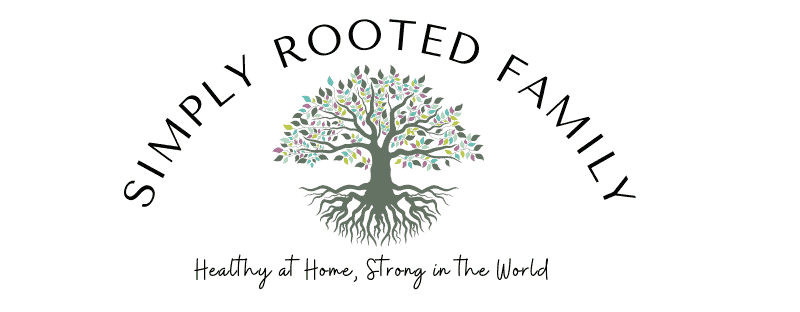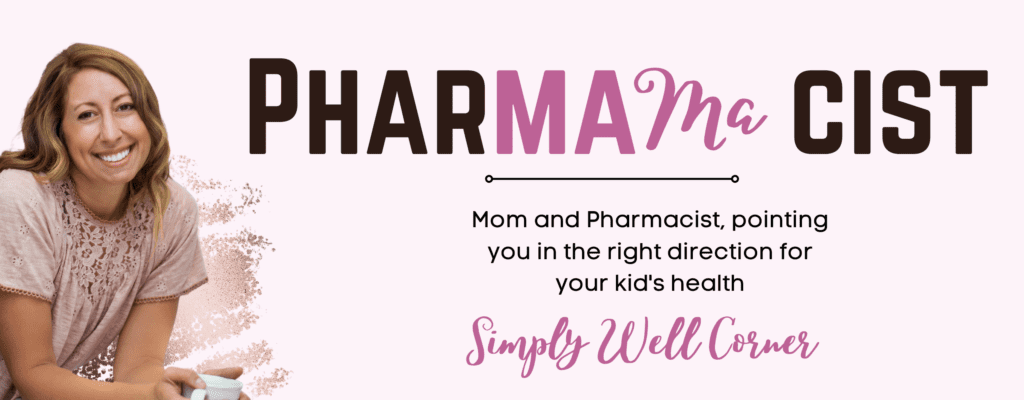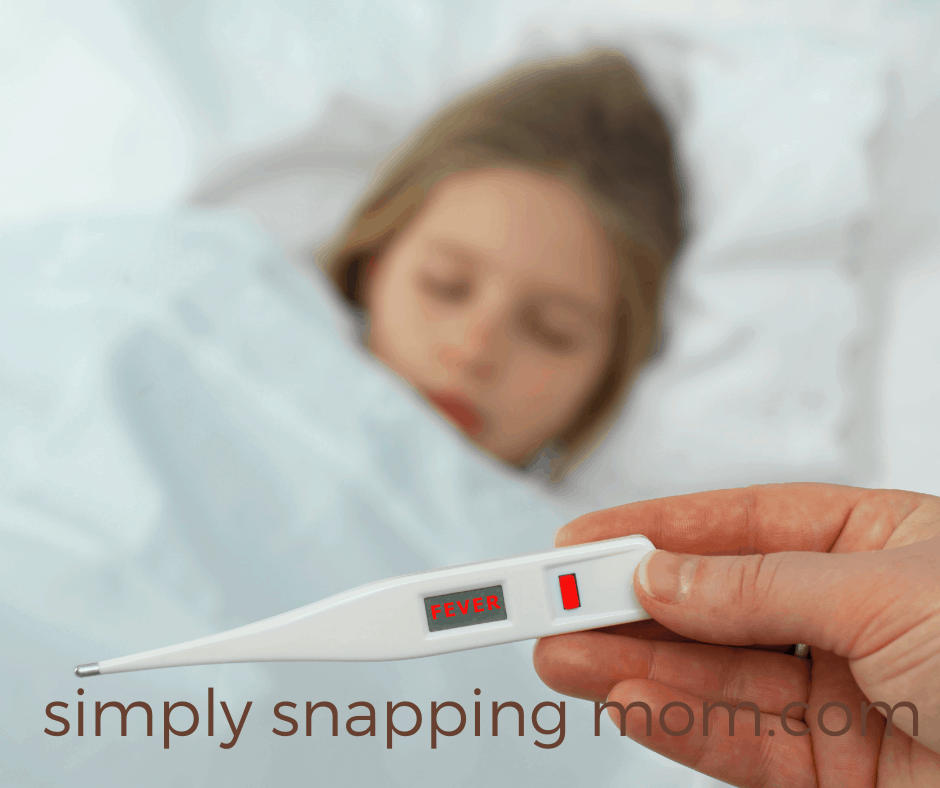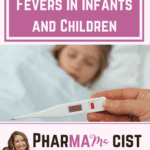As part of the Simply Well Series, we review the most frequently asked questions I receive in the pharmacy. In this edition, I answer a common question regarding how much Motrin to give a 1 year old – and everything else you want to know about dosing for pain and fevers in kids.
As a pharmacist, the most common questions I hear are “how much ibuprofen can I give my young child?” and “how do I treat my child’s fever (or pain)?”
This is no surprise as childhood fevers, pain, and other ailments are unavoidable. In fact, experts say that kids get, on average, a whopping 8 colds a year.
One particular unlucky month, my son broke his arm and had the flu. Another bleak winter, my daughter who was 14 months of age had three ear infections.
Luckily, in both scenarios, my children were able to get through these unfortunate illnesses with the right kind of medicine mixed in with the right touch of mommy love.
As parents, if you can identify when an over the counter medicine is needed, the correct dose to give your child, and how to administer the medication you will be able to best easy your child’s discomfort.
Treating Fevers and Pain in Young Kids
There are two different types of over-the-counter (OTC) medications that are safe and effective for children according to the American Academy of Pediatrics (AAP).
When you are finding the right dose for your child, it is important to know the kind of medicine (or active ingredient), your child’s weight, and when to call your health care provider.
Acetaminophen (Tylenol) and nonsteroidal anti-inflammatory drugs (Ibuprofen) are the two medications available in the United States for pediatrics. Both medications come in children’s forms because the adult dosage forms contain higher amounts of medicine; therefore, it is important to pay close attention to the age limit on the label.
As you may have guessed, Ibuprofen and other anti-inflammatory drugs work by blocking the production of a certain chemical in the body that causes inflammation. Children’s Advil and Motrin (which are both made of the generic ibuprofen) are the only OTC anti-inflammatory medications for infants and children. You can purchase the brand names or the generic – they both are equally safe and effective.
Never give your child aspirin because it can cause a rare but serious brain disorder called Reye syndrome. The AAP advises parents to use acetaminophen or ibuprofen, not aspirin.
Tips on How to Give Your Child Medication
Depending on your child’s years of age and temperament, it may be a challenge to get them to take their medication. Selecting the correct product will help greatly.
Infant drops: Drops are available for infants and children. Only ibuprofen drops are available, as the concentrated acetaminophen drops were discontinued years ago due to risk of overdose.

Oral suspensions: Both child ibuprofen and acetaminophen are available in a liquid form. One level teaspoon equals 5 mL; however, syringes and droppers are more accurate than a regular measuring spoon.
To administer liquid to an infant or young child:
- Hold your baby the same way you do when you nurse or bottle feed him or her.
- Put the syringe into your baby’s mouth and gently squirt a small amount of the medicine between his tongue and the side of his mouth (not in the back of the mouth).
- If you need to give another squirt, wait until they swallow the first one entirely.
Chewables: Both types of fever and pain relievers are available in a chewable form.
Other: There are always new dosage forms popping up with creative ways to give children medicine. For example: Tylenol now offers a “dissolve pack”. It is a powder that you pour on your child’s tongue – similar to pixie sticks.

Hacks for Getting Kids to Take Their Medicine
When my daughter was young, she absolutely refused to take medication. We even tried resorting to bribery to get her dose in, which failed miserably. These are some of the hacks we used to get her to take her medication (# 2 worked like a charm):
- Mix in their drink:
- Add the dose of liquid medicine to a glass of milk or fruit juice (preferably at room temperature).
- Make sure your child drinks all the mixture straight away.
- Then add some more juice or milk to the glass, swirl it round and ask your child to drink the liquid. This makes sure they get all the medicine.
- Top with whipped cream or sprinkles
- Give it to them in bath, when they are relaxed and calm
How Much Medicine Can I Give my Kid?
Knowing how much medication to give your child is actually quite simple. You need your child’s weight and a dosing chart. Keep in mind that a milliliter (ml), is a way to measure liquid (5 ml is equal to one teaspoonful). You will see this on any dosing syringe or dropper.
Ibuprofen Dosing Chart (do not use in kids under 6 months old unless directed to be pediatrician)
| Child’s Weight (lbs) | 12-17 | 18-23 | 24-35 | 36-47 | 48-59 | 60-71 | 72-95 | 96+ |
| Infant drops 50 mg/1.25 ml | 1.25 ml | 1.875 ml | 2.5 ml | 3.75 ml | 5 ml | |||
| Liquid 100 mg/5ml | 2.5 ml | 4 ml | 5 ml | 7.5 ml | 10 ml | 12.5 ml | 15 ml | 20 ml |
| Chewable 100 mg | – | – | 1 tablet | 1 ½ tablet | 2 tablets | 2 ½ tablets | 3 tablets | 4 tablets |
To answer a recent question regarding how much motrin to give a one year old, this would be based on the child’s weight. Locate your child’s current weight (lbs) on the top row of the dosage table. I would recommend liquid medication for this age.
Acetaminophen Dosing Chart (do not use in kids under 3 months or under 12 lbs unless advised by pediatrician)
| Child’s Weight (lbs) | 12-17 | 18-23 | 24-35 | 36-47 | 48-59 | 60-71 | 72-95 | 96+ |
| Liquid 160 mg/5ml | 2.5 ml | 3.75 ml | 5 ml | 7.5 ml | 10 ml | 12.5 ml | 15 ml | 20 ml |
| Chewable 160 mg | – | – | 1 tablet | 1 ½ tablet | 2 tablets | 2 ½ tablets | 3 tablets | 4 tablets |
When to Call the Doctor
If your child isn’t feeling well, it is important to get plenty of rest and hydration. Call your child’s doctor if your child experiences lasting diarrhea/vomiting, pain, worsening fever, rash, refusal to eat or drink or:
- infant younger than 3 months old with a rectal temperature of 100.4°F (38°C) or higher
- older child with a temperature of higher than 102.2°F (39°C)
Seek urgent medical attention help if your child experiences:
- crying that won’t stop
- extreme irritability or fussiness
- sluggishness and trouble waking up
- a rash or purple spots that look like bruises on the skin (that were not there before your child got sick)
- blue lips, tongue, or nails
- infant’s soft spot on the head seems to be bulging out or sunken in
- stiff neck
- severe headache
- limpness or refusal to move
- trouble breathing that doesn’t get better when the nose is cleared
- leaning forward and drooling
- seizure
- moderate to severe belly pain
You may also find helpful: How to Treat Constipation in Kids
Final Thoughts
We want our children to be well and safe. These simple dosing charts and hacks will help you give your child the appropriate dose of medication needed to ease their discomfort or lower their fever.
And if your child is particularly fussy about taking medications, remember that a little bit of whipped cream can go a long way.
If you found this helpful, share it and check out our other common questions in the Simply Well Corner – including the best decongestant for kids and how to dose Benadryl in kids.




